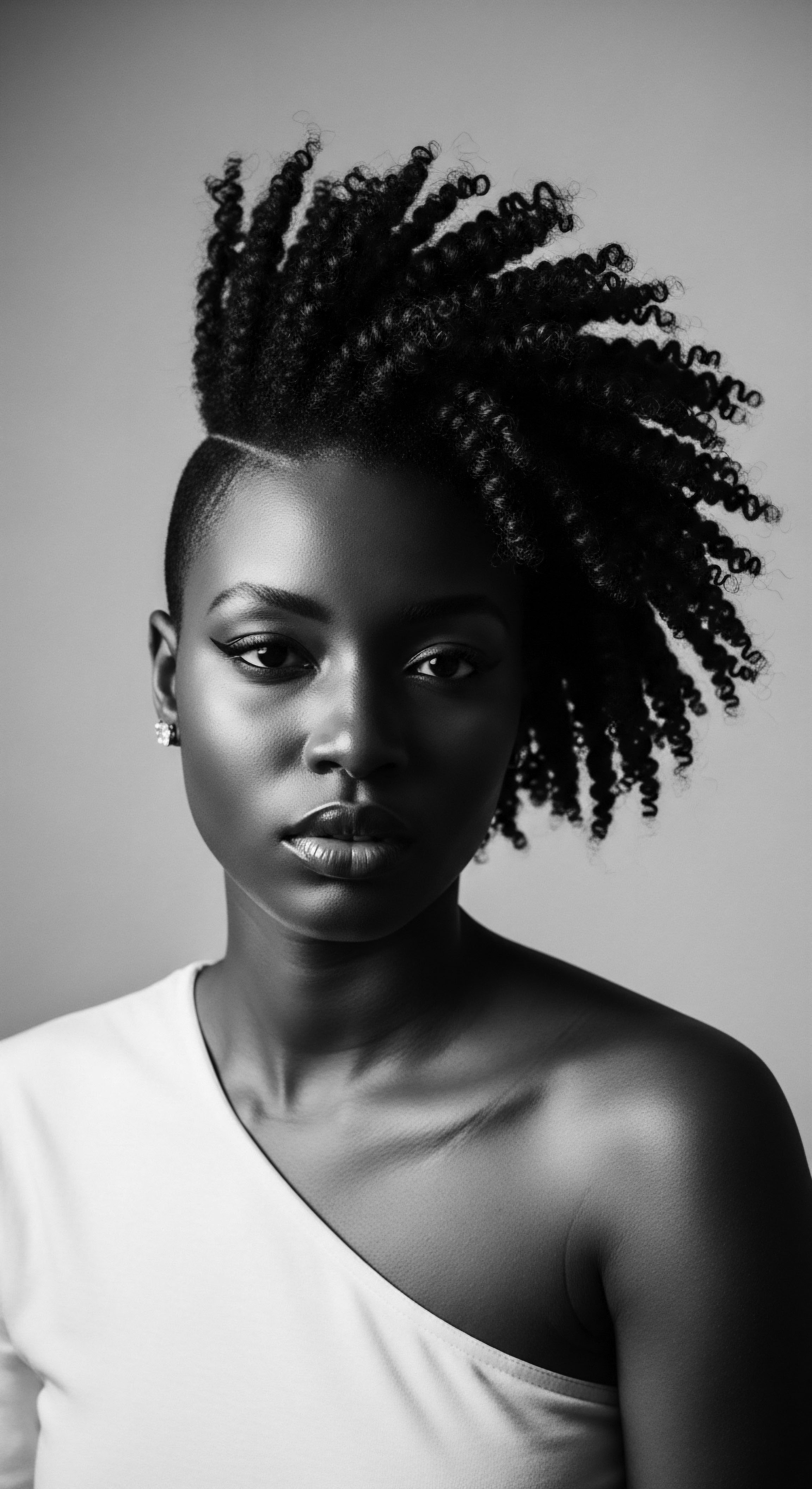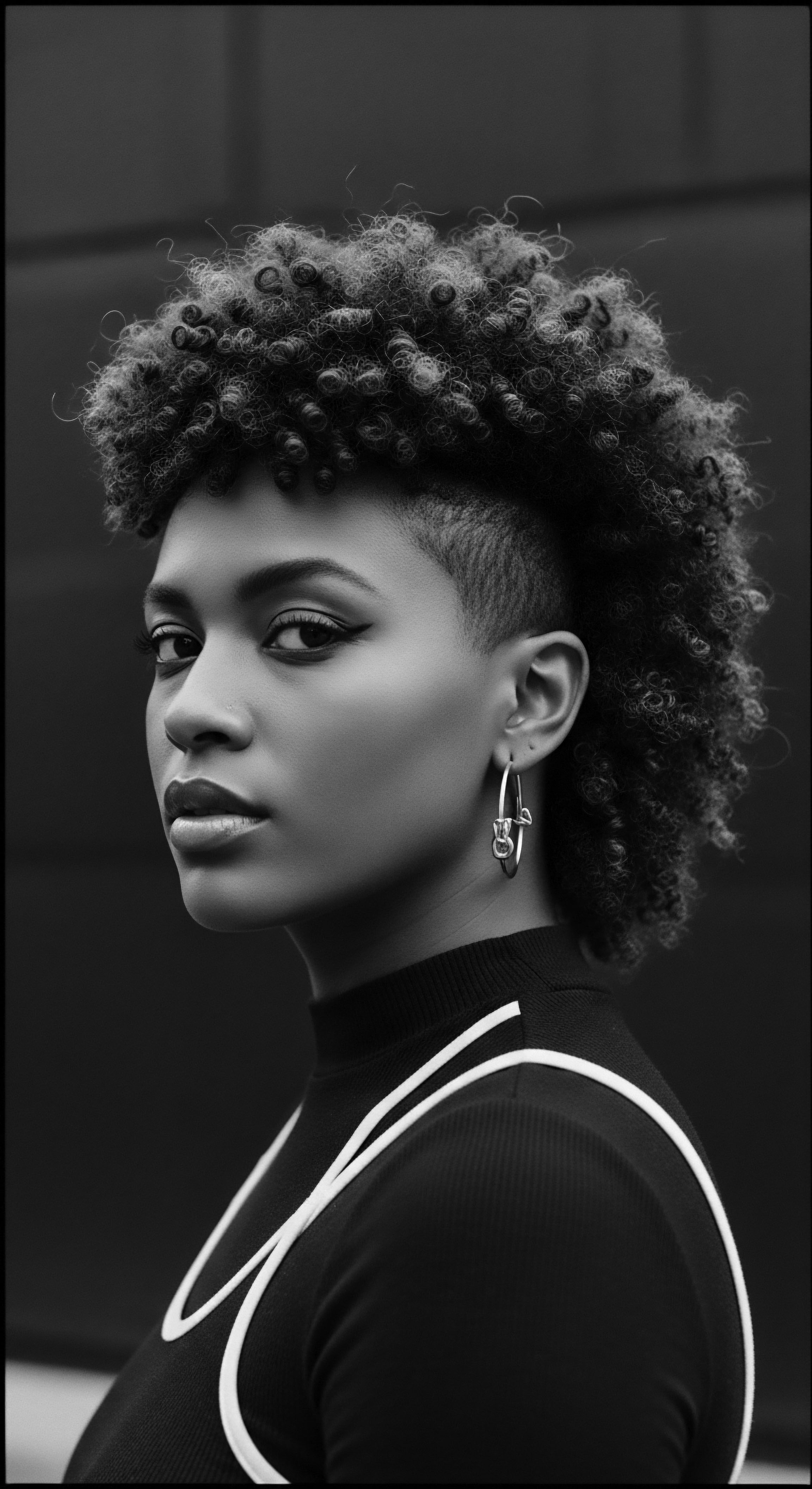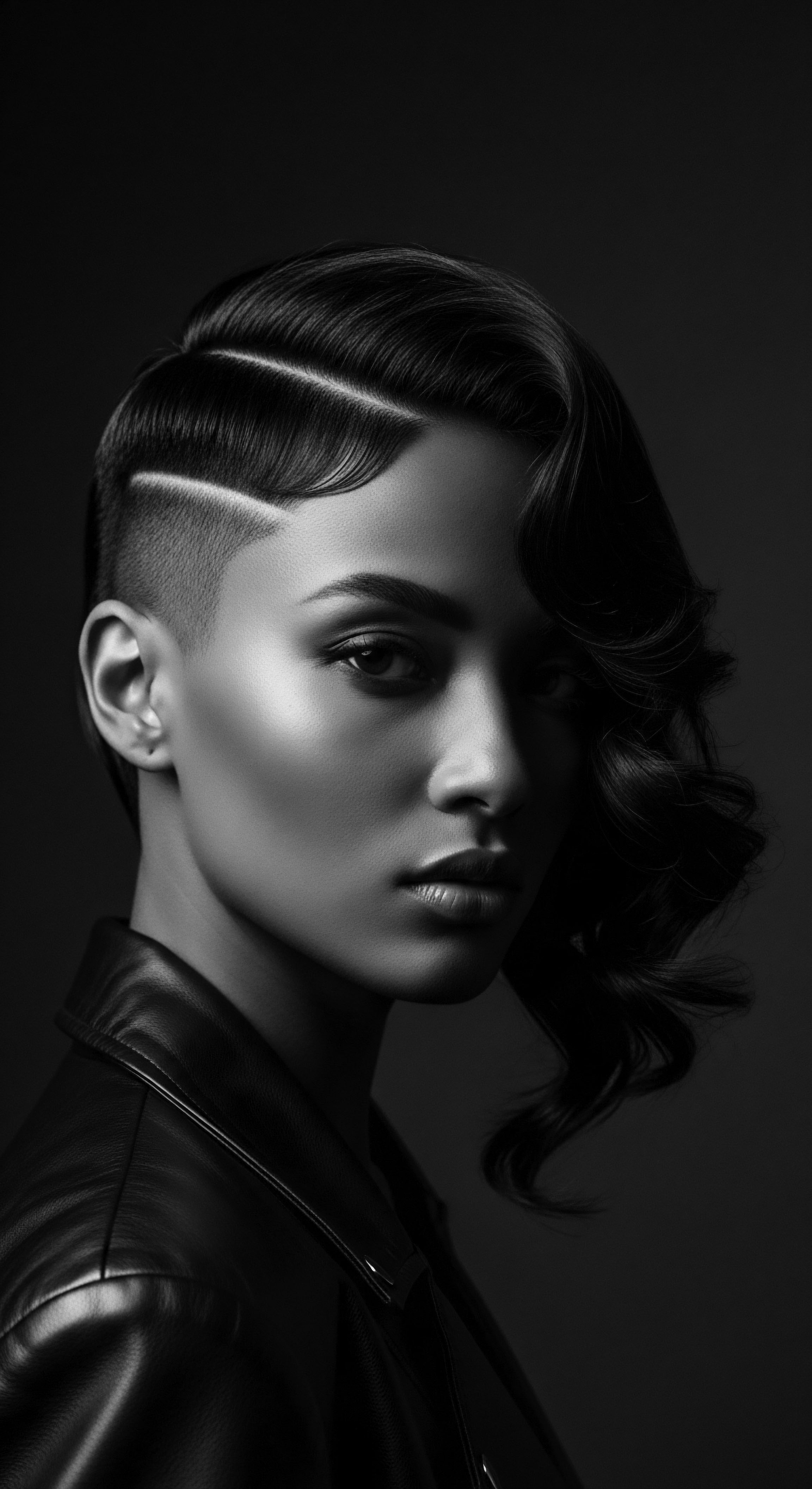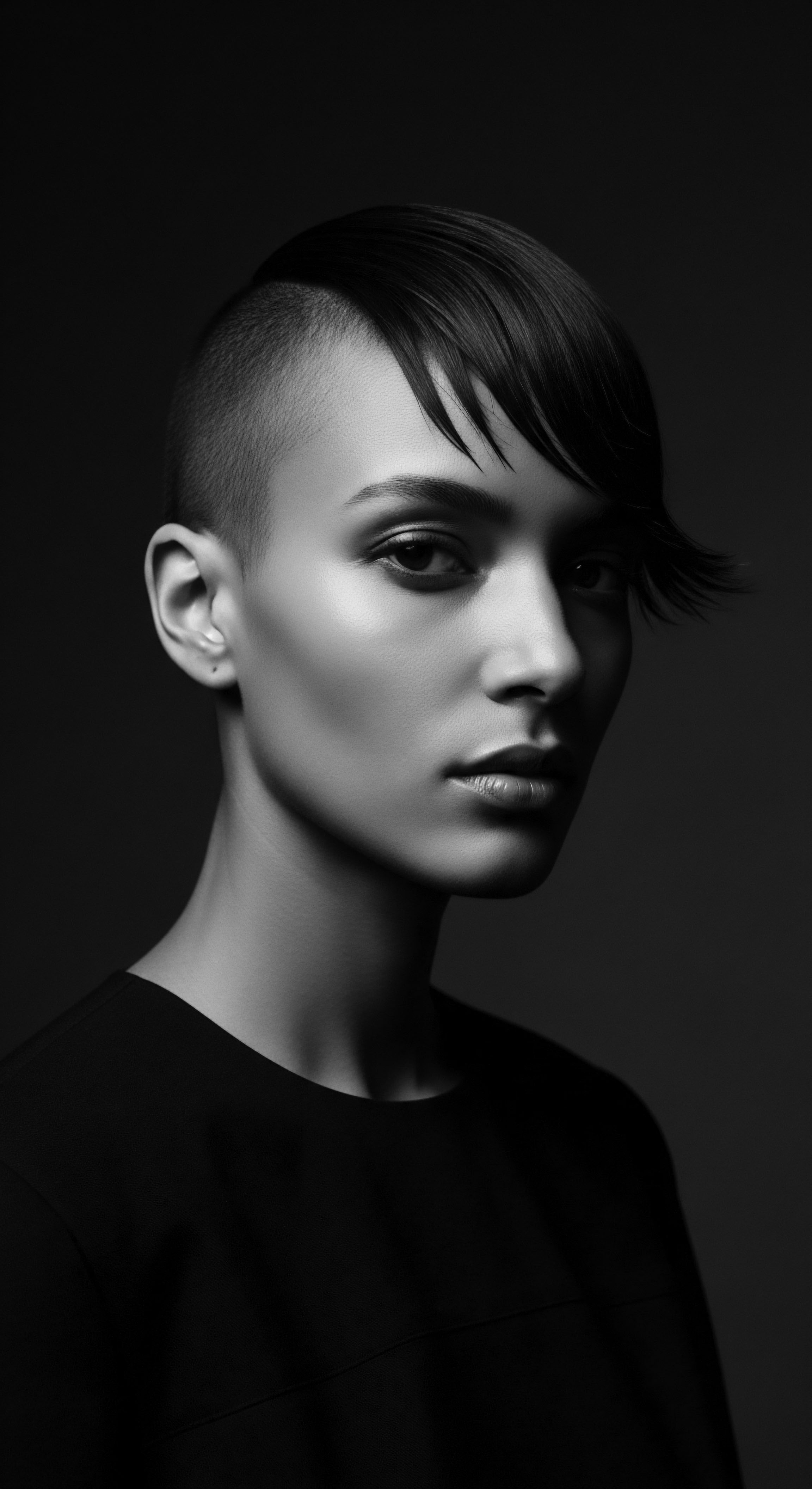
Roots
Consider, for a moment, the very strands that crown us, those coils and kinks and waves that tell a story far older than any written scroll. For those of us connected to the vast, vibrant lineage of textured hair, the question of how historical hair care shapes our daily rituals is not academic; it pulses with the lifeblood of generations. It is a quiet conversation between past and present, a whispered wisdom carried on the wind of time, from ancestral hearths to our contemporary dressing tables.
Roothea stands as a living archive, where each strand holds the memory of ancient practices and the promise of future flourishing. Our hair, in its glorious diversity, remains a profound testament to resilience, identity, and ingenuity, its very structure echoing the ingenuity of our forebears.

What is the Ancestral Fabric of Hair?
The initial understanding of textured hair’s unique architecture begins at the source, long before microscopes revealed the elliptical cross-section or the irregular curl patterns that distinguish it. Ancient cultures, particularly those across the African continent, perceived hair not as inert protein, but as a conduit, a spiritual antenna connecting individuals to the divine, to ancestors, and to community. This understanding was not merely metaphorical; it guided care practices with a reverence seldom seen in contemporary approaches.
Our hair’s inherent coil, for example, once seen as a blessing, a symbol of divine connection and vital energy, guided the very earliest forms of care. The elliptical shape of the follicle, the way the hair shaft spirals as it grows, and its tendency to aggregate into distinct patterns—these were not challenges to be straightened away but fundamental characteristics to be honored and tended.
The very structure of textured hair, with its unique coiling and elliptical cross-section, was perceived in ancestral traditions as a sacred link, guiding profound care practices.
Early human societies observed the interplay of environment, diet, and hair health with an intuitive precision. They discerned how arid climates necessitated deep hydration, how certain plant extracts brought luster, and how protective styles shielded the delicate strands from the elements. This observational wisdom laid the groundwork for what we now understand through modern biology. The cuticle layers of textured hair, often more lifted at the curves, require meticulous sealing and gentle handling—a truth understood by those who meticulously braided and oiled hair in ancient times.

How Did Early Cultures Perceive Hair’s Growth?
The rhythmic cycles of hair growth, shedding, and rest, now mapped precisely as Anagen, Catagen, and Telogen Phases, were intuitively comprehended in antiquity. While not defined by scientific terms, ancestral communities recognized the hair’s vitality, its periods of strength, and its moments of vulnerability. They understood, for instance, that during times of famine or stress, hair might thin or break, leading to practices that aimed to support overall bodily wellness alongside direct hair care. This holistic perspective, where physical condition, spiritual state, and communal harmony all played a role in hair’s presentation, is a profound inheritance.
Consider the linguistic heritage associated with hair. Across numerous African languages, terms for hair are not simply descriptive of texture but laden with cultural meaning. The Wolof word for hair, Njaxana, for instance, speaks to its density and texture.
In many Bantu languages, words for braids or specific styles often carried social status, age markers, or marital eligibility. This lexicon, vibrant with deep meaning, underscores how intimately woven hair was into the social fabric, far beyond mere aesthetics.
| Aspect Hair Shape |
| Ancestral Recognition A sacred symbol, divine connection; indicative of natural coil. |
| Modern Scientific Insight Elliptical to flat cross-section, influencing curl pattern. |
| Aspect Environmental Adaptation |
| Ancestral Recognition Observed need for moisture in dry climates; protective styling. |
| Modern Scientific Insight Understanding of cuticle lift, moisture loss, and environmental stressors. |
| Aspect Overall Wellness |
| Ancestral Recognition Hair health linked to body's vitality, spiritual state. |
| Modern Scientific Insight Recognized impact of nutrition, stress, and systemic health on hair cycles. |
| Aspect The deep respect for hair in ancient cultures often aligns with contemporary scientific findings, revealing an enduring wisdom. |
The earliest hair care regimes were guided by the raw materials of the earth. From the nourishing oils of the shea tree (Butyrospermum Parkii) in West Africa to the cleansing clays of the Nile, communities relied on local botanicals. These ingredients, selected for their observed properties—their ability to soften, cleanse, lubricate, or protect—formed the basis of an intricate knowledge system passed down through oral traditions. This elemental biology, recognized through generations of trial and observation, continues to inform many natural hair product formulations today, a direct lineage from ancient practices to modern applications.

Ritual
The journey of textured hair care from its ancient roots finds expression in the elaborate rituals and styling techniques that have persisted and transformed across time and geography. These practices are not mere acts of beautification; they are profound cultural statements, repositories of history, and acts of communal bonding. The tender touch of hands weaving strands has, for centuries, been a vehicle for storytelling, for instruction, and for the quiet transmission of heritage. This is where the art and science of textured hair truly intersect, revealing how ancestral methodologies have adapted and survived, sometimes against formidable odds.

What is the Enduring Legacy of Protective Styles?
Protective styling, a practice central to the care of textured hair, possesses an ancestral lineage that spans millennia. Braids, twists, and locs were not merely stylistic choices in ancient African societies; they served practical purposes of hygiene, protection from environmental damage, and symbolic communication. The intricate braid patterns found on ancient Egyptian busts, for example, speak to a highly sophisticated understanding of hair manipulation and adornment. These styles shielded hair from dust, sun, and breakage, while also signifying tribal affiliation, social status, and marital standing.
- Cornrows ❉ Originating in various African cultures, these tightly braided rows against the scalp served as maps, symbols of agricultural prosperity, or even indicators of religious devotion. Their protective function, minimizing tangling and breakage, remains a cornerstone of textured hair care today.
- Locs ❉ Beyond their spiritual significance in many indigenous traditions and later in Rastafarianism, locs were a practical method of hair management, allowing for growth without daily manipulation, a testament to low-maintenance protective styling.
- Knotless Braids ❉ A modern iteration of traditional braiding, evolving to reduce tension at the root, a subtle but significant refinement building upon centuries-old techniques.
The tools employed in these historical styling practices, though rudimentary by today’s standards, were incredibly effective. Bone combs, wooden picks, and sharpened sticks were meticulously crafted to detangle, separate, and sculpt hair. These implements, often carved with symbolic motifs, were sacred objects in their own right. The modern wide-tooth comb and detangling brush are direct descendants of these ancestral tools, each iteration striving to honor the hair’s delicate structure, a lesson gleaned from generations of careful handling.

How Did Adornment Transform Hair Narratives?
Hair extensions and wigs also hold a venerable place in the heritage of textured hair. In ancient Kemet, elaborate wigs crafted from human hair, plant fibers, or wool were symbols of wealth, status, and cleanliness. These were not merely fashion accessories but served practical functions in a hot climate, providing protection from the sun while offering a surface for perfumed oils.
The re-emergence of hair extensions and wigs in contemporary Black communities speaks to a continuation of this cultural practice, albeit with modern materials and techniques. It reflects a desire for versatility, protection, and self-expression, echoes of ancient expressions of identity.
Hair manipulation, from ancient braids signifying social standing to modern extensions offering versatility, remains a powerful medium for identity and cultural expression across generations.
The application of heat in hair care also traces a complex historical trajectory. While modern flat irons and curling wands present new challenges to hair integrity, historical methods often used warm combs or heated sticks to achieve certain textures or styles, particularly in straightening. The objective was often temporary alteration for ceremonial purposes or specific aesthetic ideals within a cultural context, understood as a tool rather than a daily routine. This contrasts sharply with the contemporary pressure for daily thermal manipulation, prompting a renewed focus on protective, low-heat alternatives, a return to ancestral wisdom regarding hair preservation.
The communal aspect of hair styling, especially within Black and mixed-race communities, persists as a powerful cultural memory. Historically, braiding sessions were profound social gatherings—places where elders shared wisdom, where children learned traditions, and where bonds were strengthened. These were not merely appointments; they were occasions for collective care and cultural transmission. The enduring practice of salon visits, barbershop gatherings, or even kitchen table styling sessions among families carries the echoes of these ancient communal rituals, reaffirming the truth that hair care is, at its core, a shared heritage.
| Purpose Detangling/Parting |
| Historical Tools/Methods Bone combs, sharpened sticks, fingers |
| Modern Counterparts/Refinements Wide-tooth combs, detangling brushes, rat-tail combs for precise parting |
| Purpose Styling/Sculpting |
| Historical Tools/Methods Clay, plant gums, natural fibers for extensions |
| Modern Counterparts/Refinements Styling gels, creams, hair extensions (synthetic/human hair) |
| Purpose Heat Application |
| Historical Tools/Methods Warmed combs, fire-heated sticks (for temporary alteration) |
| Modern Counterparts/Refinements Ceramic flat irons, curling wands (requiring thermal protection) |
| Purpose The function of hair tools remains consistent, reflecting an ongoing effort to manage and adorn textured hair, with modern technology refining ancient principles. |

Relay
The legacy of historical hair care is not confined to static museum exhibits or dusty tomes; it is a living, breathing regimen that continues to shape daily practices for textured hair today. The “relay” of ancestral knowledge across generations, often through oral tradition and lived experience, is the very bedrock upon which contemporary routines are built. This segment delves into how this continuous transmission informs our holistic approach to hair health, influences our ingredient choices, and shapes our problem-solving strategies, always with a deep respect for the wisdom passed down.

How Does Ancestral Wisdom Inform Modern Hair Regimens?
Building a robust hair regimen today, particularly for textured hair, often involves an intuitive gravitation towards practices that mirror ancestral wisdom. The emphasis on moisture retention, scalp health, and low-manipulation styling finds deep roots in historical practices aimed at preserving hair in diverse environments. For instance, the practice of nightly wrapping or covering hair, now commonly done with silk or satin bonnets, is a direct continuation of ancestral methods designed to protect hair during sleep, preventing tangling and moisture loss.
These coverings, once simple cloths or specialized headwraps, maintained the integrity of elaborate daytime styles and kept hair clean. The quiet ritual of preparation for rest, tending to one’s crown before slumber, is a thread woven from the loom of antiquity.
The choice of ingredients in hair care is another powerful echo of the past. Before the advent of synthetic compounds, communities relied exclusively on the bounty of their local ecosystems.
- Shea Butter ❉ From West Africa, prized for its emollient properties, it sealed moisture and protected hair from harsh elements. Modern formulations still rely on its rich, restorative qualities.
- Jojoba Oil ❉ While native to the American Southwest, its chemical structure closely mimics the natural sebum of the scalp, making it an excellent historical and contemporary choice for balancing scalp oils and conditioning hair.
- Aloe Vera ❉ Used across various ancient civilizations for its soothing and hydrating properties, often applied to the scalp to alleviate irritation and promote a healthy environment for growth.
- Fenugreek (Methi) ❉ An ancient spice used in South Asian and Middle Eastern hair traditions for strengthening strands and promoting density, often steeped to create a conditioning rinse or mask.
These ingredients, once harvested and prepared through laborious ancestral methods, are now available globally, allowing a wider audience to benefit from their centuries-tested efficacy. The understanding of their potency, however, comes from generations of direct observation and application.

What Historical Examples Guide Current Problem Solving?
When textured hair faces challenges—be it dryness, breakage, or scalp irritation—the solutions often draw from a wellspring of historical ingenuity. Consider the phenomenon of hair loss or thinning. While modern science offers complex treatments, historical communities often turned to botanical remedies and specific dietary changes, understanding the interplay between internal health and external hair presentation. A compelling historical instance comes from the practices of certain Indigenous communities in the Amazon, who utilized the oil from the Pataua Palm (Oenocarpus Bataua).
This oil, rich in oleic acid and antioxidants, was applied to the scalp and hair not only for conditioning but also to address weakness and promote vitality, an observational practice documented by early ethnobotanists (Schultes, 1970). This ancestral knowledge of specific botanicals for hair vitality continues to shape natural hair product development, offering a heritage-backed approach to common hair concerns.
Ancestral wisdom, from nightly hair protection to the intentional selection of botanical ingredients, forms the enduring foundation for contemporary textured hair care regimens.
The concept of holistic wellness, deeply embedded in many ancestral cultures, asserts that true hair health radiates from within. This perspective, often lost in modern fragmented approaches to beauty, viewed hair not in isolation but as an integral part of the whole being—connected to diet, stress levels, spiritual alignment, and communal well-being. Practices like mindful scalp massage, once performed as a ritual for relaxation and blood circulation, are now validated by scientific understanding of microcirculation’s role in follicle health. This profound understanding that hair responds to the body’s overall harmony and dis-ease is a powerful relay from our heritage, urging us to consider more than just topical applications.
The resilience of textured hair, often underappreciated in mainstream beauty narratives, is a narrative inherited from communities who have long navigated its unique needs. This resilience is not simply physical but deeply cultural, born from centuries of adapting and innovating care practices. The journey from traditional remedies, often concocted in homes, to the sophisticated natural hair market of today, reveals a continuous search for effective, heritage-aligned solutions that honor the hair’s inherent beauty and strength.

Reflection
The conversation between past and present, between ancestral hands and modern products, flows ceaselessly within the realm of textured hair care. How does historical hair care shape current practices? It is a question answered not in a single pronouncement but in the continuous hum of our daily rituals, the knowing glance at a natural ingredient, and the quiet pride in a protective style.
Each act of tending to textured hair today is a conscious or unconscious echo of journeys long undertaken, of wisdom patiently garnered, and of resilience etched into the very helix of each strand. Our care practices stand as a living testament to an unbroken chain of knowledge, passed down through generations, often surviving against intentional erasure.
The ‘Soul of a Strand’ whispers that our hair is more than keratin and pigment; it is a repository of memory, a map of migration, and a canvas for identity. It demands a care that is not merely cosmetic but reverent, a practice that honors the ingenuity of our ancestors and the profound beauty they found in their own crowning glory. As we select our conditioners, choose our styling tools, or sit for hours to have our braids installed, we are, in a profound sense, participating in a sacred relay. We are both students and teachers, beneficiaries of a vast heritage, and contributors to its ongoing narrative.
The future of textured hair care, then, is not about severing ties with the past but about deepening our connection to it. It is about understanding that the seemingly modern challenges of dryness or breakage were often met with wisdom millennia ago. It means recognizing that the quest for hair health is, in essence, a quest for self-knowledge, a return to the source of strength and beauty found in our collective heritage. In every gentle touch, every nourishing application, every celebratory style, we keep the ancient wisdom alive, ensuring that the soul of each strand continues to tell its powerful, enduring story.

References
- Schultes, Richard Evans. (1970). Ethnobotany of the Guianas. Botanical Museum Leaflets, Harvard University.
- Byrd, Ayana, & Tharps, Lori L. (2014). Hair Story ❉ Untangling the Roots of Black Hair in America. St. Martin’s Press.
- Mercer, Kobena. (1994). Welcome to the Jungle ❉ New Positions in Black Cultural Studies. Routledge.
- Okoro, Noliwe. (2018). Black Hair ❉ A Cultural and Aesthetic History. Ohio University Press.
- Sweet, Roxanne. (2017). Natural Hair ❉ A Guide to the Coils, Kinks, and Waves of Black Hair. Ten Speed Press.
- Potter, Ann M. (2020). The Science of Black Hair ❉ A Comprehensive Guide to Textured Hair Care. CreateSpace Independent Publishing Platform.
- Hooks, bell. (2015). Black Looks ❉ Race and Representation. Routledge.
- Opoku, Kwabena. (1970). African Hair Styles. Ghana Publishing Corporation.
